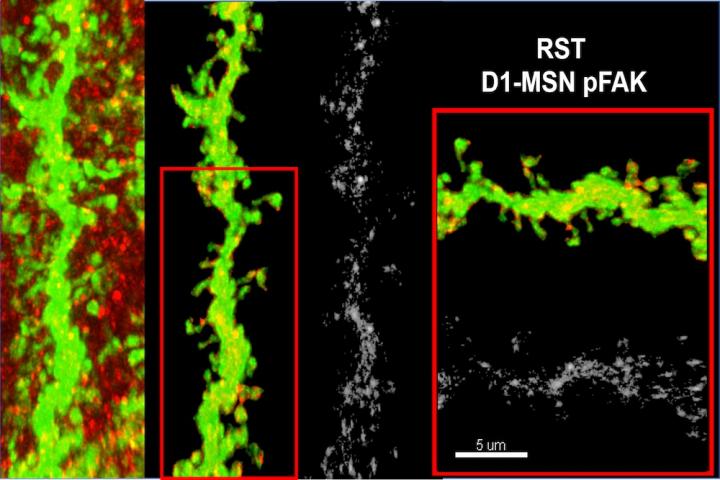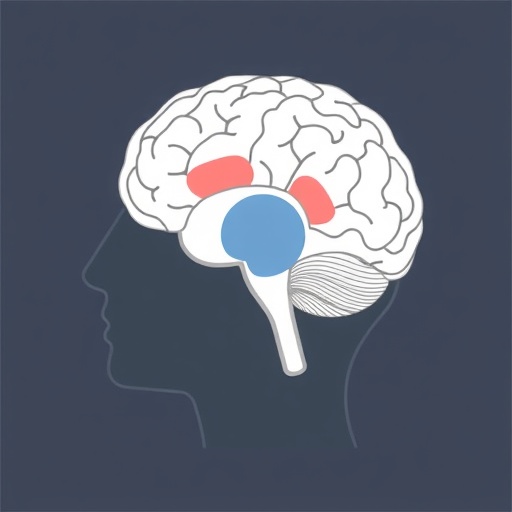Researchers at the Medical University of South Carolina and the National Institutes of Health uncover how drug cues change the connectivity between brain cells, making it more difficult to stop seeking drugs.

Credit: Image courtesy of Dr. Peter Kalivas and Dr. Garcia-Keller. Medical University of South Carolina
In the October 28, 2020 issue of the Journal of Neuroscience, researchers from the Medical University of South Carolina and the National Institutes of Health describe how reminders of drug use can change specific brain cells responsible for motivation, increasing the desire to seek drugs. Connections between these and other brain cells strengthen because the dendritic spines, the parts of the brain cells that receive messages from other neurons, enlarge in response to intercellular communication by molecules in the brain. This enhanced connectivity increases the urge to engage in drug use, making relapse more likely. Understanding this communication pathway could lead to more targeted treatments for drug addiction.
The study was led by MUSC Department of Neuroscience professor Peter W. Kalivas, Ph.D., and assistant professor Constanza Garcia-Keller, Ph.D., who works in the Kalivas lab.
For decades, the Kalivas laboratory has been studying the mechanisms behind drug addiction. In previous studies, Kalivas and his team have shown that an increase in the size of these spines correlates with how much an animal will work for a drug, such as cocaine. Interestingly, these spines enlarge in response to signals sent not from other neurons but from the extracellular matrix that surrounds these cells. They found that these signals from outside the brain cells lead to internal changes in the neurons to change their connections to other neurons.
“The key finding is that enlargement of spines is necessary and induced by cues that are associated with addictive drugs, not cues that are associated with natural rewards,” explained Kalivas.
That’s an important distinction because it means that treatments can be developed to diminish the cravings for drugs without depriving patients of pleasurable experiences.
The researchers were able to image the fine details of the neurons in the nucleus accumbens of the brain, a region that has been implicated in driving drug addiction, with high-resolution confocal microscopy. They could see how the spines changed under different conditions and could even visualize the signaling molecules inside the cells that led to the increase in spine size.
One of these molecules in the neurons is focal adhesion kinase (FAK). When Kalivas and his team inhibited this protein with a drug, the animals did not seek cocaine when exposed to a reminder of the drug. In addition, they showed that modifications to this kinase and the actin-binding protein cofilin led to spine enlargement and enhanced connections in a specific cell type in the brain known as D1-medium spiny neurons -neurons in the nucleus accumbens that motivate behavior.
“There are actually two cell groups in the nucleus accumbens. One motivates, and the other puts the brakes on behavior,” said Kalivas. “Our study showed that this signaling is going through the cell group that promotes motivating behavior and not so much the cell group that is responsible for inhibiting behavior.”
In other words, the cocaine is changing brain structure and function, especially in D1-medium spiny neurons, to motivate the animal to seek more cocaine.
Better understanding how drug reminders change neuronal structure by altering brain signaling will be crucial to developing effective therapies to avoid relapse.
“The long-range goal is to establish therapies to help to prevent or reduce this relapse event that happens in people who try to recover,” said Garcia-Keller. “However, we first need to understand the signaling system better before we devise novel pharmacological treatments.”
###
About the Medical University of South Carolina
Founded in 1824 in Charleston, MUSC is the oldest medical school in the South, as well as the state’s only integrated, academic health sciences center with a unique charge to serve the state through education, research and patient care. Each year, MUSC educates and trains more than 3,000 students and nearly 800 residents in six colleges: Dental Medicine, Graduate Studies, Health Professions, Medicine, Nursing and Pharmacy. The state’s leader in obtaining biomedical research funds, in fiscal year 2019, MUSC set a new high, bringing in more than $284 million. For information on academic programs, visit musc.edu.
As the clinical health system of the Medical University of South Carolina, MUSC Health is dedicated to delivering the highest quality patient care available, while training generations of competent, compassionate health care providers to serve the people of South Carolina and beyond. Comprising some 1,600 beds, more than 100 outreach sites, the MUSC College of Medicine, the physicians’ practice plan, and nearly 275 telehealth locations, MUSC Health owns and operates eight hospitals situated in Charleston, Chester, Florence, Lancaster and Marion counties. In 2019, for the fifth consecutive year, U.S. News & World Report named MUSC Health the No. 1 hospital in South Carolina. To learn more about clinical patient services, visit muschealth.org.
MUSC and its affiliates have collective annual budgets of $3.2 billion. The more than 17,000 MUSC team members include world-class faculty, physicians, specialty providers and scientists who deliver groundbreaking education, research, technology and patient care.
Media Contact
Heather Woolwine
[email protected]
Related Journal Article
http://dx.




